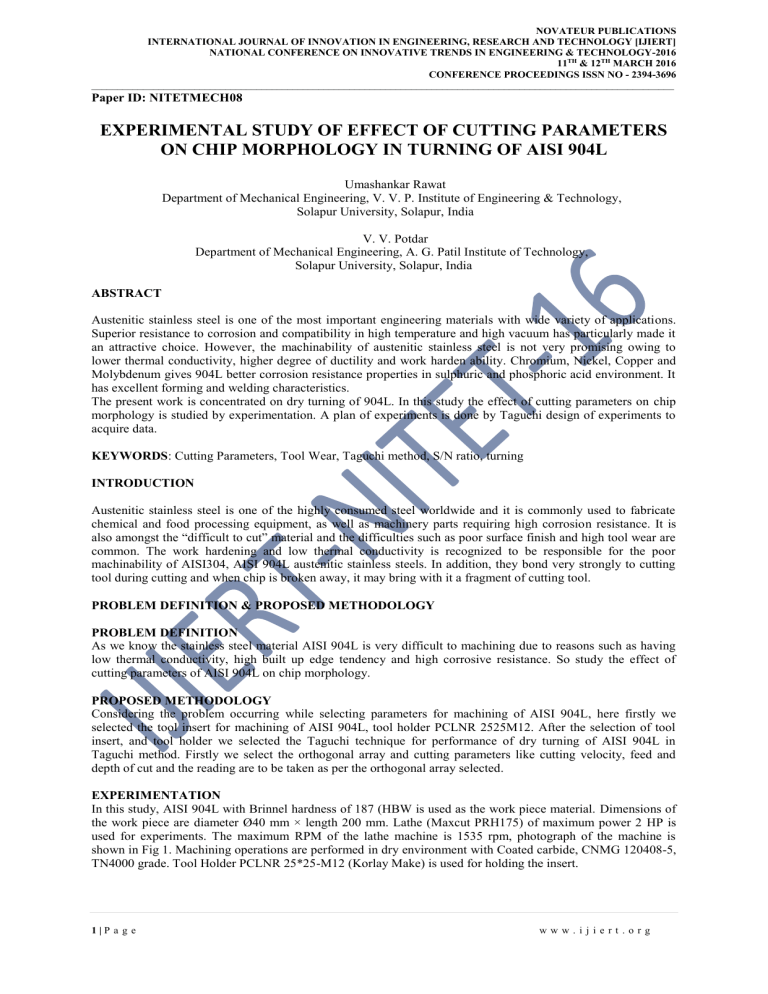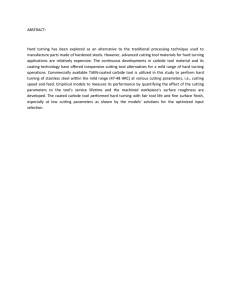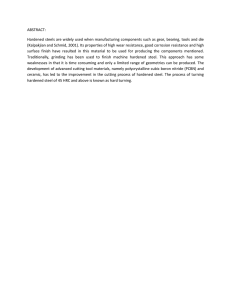experimental study of effect of cutting parameters on chip

NOVATEUR PUBLICATIONS
INTERNATIONAL JOURNAL OF INNOVATION IN ENGINEERING, RESEARCH AND TECHNOLOGY [IJIERT]
NATIONAL CONFERENCE ON INNOVATIVE TRENDS IN ENGINEERING & TECHNOLOGY-2016
11
TH
& 12
TH
MARCH 2016
CONFERENCE PROCEEDINGS ISSN NO - 2394-3696
_________________________________________________________________________________________________________________
Paper ID: NITETMECH08
EXPERIMENTAL STUDY OF EFFECT OF CUTTING PARAMETERS
ON CHIP MORPHOLOGY IN TURNING OF AISI 904L
Umashankar Rawat
Department of Mechanical Engineering, V. V. P. Institute of Engineering & Technology,
Solapur University, Solapur, India
V. V. Potdar
Department of Mechanical Engineering, A. G. Patil Institute of Technology,
Solapur University, Solapur, India
ABSTRACT
Austenitic stainless steel is one of the most important engineering materials with wide variety of applications.
Superior resistance to corrosion and compatibility in high temperature and high vacuum has particularly made it an attractive choice. However, the machinability of austenitic stainless steel is not very promising owing to lower thermal conductivity, higher degree of ductility and work harden ability. Chromium, Nickel, Copper and
Molybdenum gives 904L better corrosion resistance properties in sulphuric and phosphoric acid environment. It has excellent forming and welding characteristics.
The present work is concentrated on dry turning of 904L. In this study the effect of cutting parameters on chip morphology is studied by experimentation. A plan of experiments is done by Taguchi design of experiments to acquire data.
KEYWORDS : Cutting Parameters, Tool Wear, Taguchi method, S/N ratio, turning
INTRODUCTION
Austenitic stainless steel is one of the highly consumed steel worldwide and it is commonly used to fabricate chemical and food processing equipment, as well as machinery parts requiring high corrosion resistance. It is also amongst the “difficult to cut” material and the difficulties such as poor surface finish and high tool wear are common. The work hardening and low thermal conductivity is recognized to be responsible for the poor machinability of AISI304, AISI 904L austenitic stainless steels. In addition, they bond very strongly to cutting tool during cutting and when chip is broken away, it may bring with it a fragment of cutting tool.
PROBLEM DEFINITION & PROPOSED METHODOLOGY
PROBLEM DEFINITION
As we know the stainless steel material AISI 904L is very difficult to machining due to reasons such as having low thermal conductivity, high built up edge tendency and high corrosive resistance. So study the effect of cutting parameters of AISI 904L on chip morphology.
PROPOSED METHODOLOGY
Considering the problem occurring while selecting parameters for machining of AISI 904L, here firstly we selected the tool insert for machining of AISI 904L, tool holder PCLNR 2525M12. After the selection of tool insert, and tool holder we selected the Taguchi technique for performance of dry turning of AISI 904L in
Taguchi method. Firstly we select the orthogonal array and cutting parameters like cutting velocity, feed and depth of cut and the reading are to be taken as per the orthogonal array selected.
EXPERIMENTATION
In this study, AISI 904L with Brinnel hardness of 187 (HBW is used as the work piece material. Dimensions of the work piece are diameter Ø40 mm × length 200 mm. Lathe (Maxcut PRH175) of maximum power 2 HP is used for experiments. The maximum RPM of the lathe machine is 1535 rpm, photograph of the machine is shown in Fig 1. Machining operations are performed in dry environment with Coated carbide, CNMG 120408-5,
TN4000 grade. Tool Holder PCLNR 25*25-M12 (Korlay Make) is used for holding the insert.
1 | P a g e w w w . i j i e r t . o r g
NOVATEUR PUBLICATIONS
INTERNATIONAL JOURNAL OF INNOVATION IN ENGINEERING, RESEARCH AND TECHNOLOGY [IJIERT]
NATIONAL CONFERENCE ON INNOVATIVE TRENDS IN ENGINEERING & TECHNOLOGY-2016
11
TH
& 12
TH
MARCH 2016
CONFERENCE PROCEEDINGS ISSN NO - 2394-3696
_________________________________________________________________________________________________________________
Figure 1: Lathe Maxcut PRH175
TURNING CONDITIONS AND EXPERIMENTAL DESIGN
Type of cutting velocity, feed rate and depth of cut are considered as turning parameters. The ranges of turning parameters are selected as recommended from the tool manufacturer. Experimental plan is organized according to the Taguchi method for the three factors and three level designs (L27 orthogonal array).
Sr No.
Table 1: Macro morphology of chip obtained at different cutting speed
SPEED
(rpm)
DOC
(mm)
FEED
(mm/rev)
Photograph of Chip
1 202 0.133 0.15
2 202 0.133 0.2
3 202 0.133 0.25
4 202 0.167 0.15
5 202 0.167 0.2
6 202 0.167 0.25
7 202 0.267 0.15
2 | P a g e w w w . i j i e r t . o r g
NOVATEUR PUBLICATIONS
INTERNATIONAL JOURNAL OF INNOVATION IN ENGINEERING, RESEARCH AND TECHNOLOGY [IJIERT]
NATIONAL CONFERENCE ON INNOVATIVE TRENDS IN ENGINEERING & TECHNOLOGY-2016
11
TH
& 12
TH
MARCH 2016
CONFERENCE PROCEEDINGS ISSN NO - 2394-3696
_________________________________________________________________________________________________________________
8 202 0.267 0.2
9 202 0.267 0.25
10 303 0.133 0.15
11 303 0.133 0.2
12 303 0.133 0.25
13 303 0.167 0.15
14 303 0.167 0.2
15 303 0.167 0.25
16 303 0.267 0.15
17 303 0.267 0.2
18 303 0.267 0.25
3 | P a g e w w w . i j i e r t . o r g
NOVATEUR PUBLICATIONS
INTERNATIONAL JOURNAL OF INNOVATION IN ENGINEERING, RESEARCH AND TECHNOLOGY [IJIERT]
NATIONAL CONFERENCE ON INNOVATIVE TRENDS IN ENGINEERING & TECHNOLOGY-2016
11
TH
& 12
TH
MARCH 2016
CONFERENCE PROCEEDINGS ISSN NO - 2394-3696
_________________________________________________________________________________________________________________
19 455 0.133 0.15
20 455 0.133 0.2
21 455 0.133 0.25
22 455 0.167 0.15
23 455 0.167 0.2
24 455 0.167 0.25
25 455 0.267 0.15
26 455 0.267 0.2
27 455 0.267 0.25
CONCLUSIONS
From above table, at various spindle speeds (i.e. at 202, 303, 455 rpm), Feed (0.133, 0.167, 0.267 mm/rev) &
Depth of Cut (0.15, 0.20, 0.25 mm) it is observed that the chip flow rate is continuous for maximum observations & surface finish is better for all these observations. But, the observation no.1, 2, 3, 10, 14, 19, and
22 shows the discontinuous chip formation. The cutting speed & depth of cut are low but feed rate is high, due to that the tool moves in faster therefore chip produced is discontinuous. Cutting speed has important effect on various chip characteristics.
4 | P a g e w w w . i j i e r t . o r g
NOVATEUR PUBLICATIONS
INTERNATIONAL JOURNAL OF INNOVATION IN ENGINEERING, RESEARCH AND TECHNOLOGY [IJIERT]
NATIONAL CONFERENCE ON INNOVATIVE TRENDS IN ENGINEERING & TECHNOLOGY-2016
11
TH
& 12
TH
MARCH 2016
CONFERENCE PROCEEDINGS ISSN NO - 2394-3696
_________________________________________________________________________________________________________________
ACKNOWLEDGEMENT
This paper bears impart of many people. It is joyful occasion for all of us to publish our paper. I would like to express my deep sense of gratitude to my guide, teachers and friends for giving valuable time, precious guidance which helped us in completion of paper successfully.
REFERENCES
[1] Nithyanandhan T. et al “Optimization of Cutting Forces, Tool Wear and Surface Finish in Machining of AISI
304 Stainless Steel Material Using Taguchi’s Method”, International Journal of Innovative Science, Engineering
& Technology, Vol. 1 Issue 4, June 2014, page 488-493
[2] D. Philip Selvaraj et al “Optimization of surface roughness of AISI 304 austenitic stainless steel in dry turning operation using Taguchi method”, Journal of Engineering Science and Technology Vol. 5, No. 3 (2010) page 293 – 301, © School of Engineering, Taylor’s University College
[3] Samrudhi Rao et al “An Overview of Taguchi Method: Evolution, Concept and Interdisciplinary
Applications”, International Journal of Scientific & Engineering Research, Volume 4, Issue 10, October-2013, page 621-626
[4] Krishankant et al “Application of Taguchi Method for Optimizing Turning Process by the effects of
Machining Parameters”, International Journal of Engineering and Advanced Technology (IJEAT) ISSN: 2249 –
8958, Volume-2, Issue-1, October 2012, page 263-274
[5] Quazi T Z et al “a case study of Taguchi method in the optimization of turning parameters”, International
Journal of Emerging Technology and Advanced Engineering Website: www.ijetae.com (ISSN 2250-2459, ISO
9001:2008 Certified Journal, Volume 3, Issue 2, February 2013), page 616-626
[6] Atul Kulkarni et al “Design optimization of cutting parameters for turning of AISI 304 austenic stainless steel using Taguchi method”, Indian Journal of engineering & material sciences, vol. 20, August 2013, page 252-258
[7] W. H. Yang et al “Design optimization of cutting parameters for turning operations based on Taguchi method”, Journal of materials processing technology 84(1998), page 122-129
[8] M. Adinarayana et al “Parametric analysis and multi objective optimization of cutting parameters in turning operation of AISI 4340 ally steel with CVD cutting tool”, International Journal of Research in Engineering and
Technology eISSN: 2319-1163 | pISSN: 2321-7308, page 449-456
[9] Vikas B. Magdum et al “Evaluation and Optimization of Machining Parameter for turning of EN 8 steel”,
International Journal of Engineering Trends and Technology (IJETT) - Volume4 Issue5- May 2013, page 1564-
1568
[10] Mihir T. Patel et al “Optimization of Machining Parameters for Turning Different Alloy Steel Using CNC -
Review”, International Journal of Innovative Research in Science, Engineering and Technology (An ISO 3297:
2007 Certified Organization) Vol. 3, Issue 2, February 2014, page 9423-9430
[11] Metal cutting & tool design by Dr. B. J. Rangnath, Second revised edition, Vikas Publishing House Pvt.
Ltd. New Delhi, India. Page: 17-34, 42-63, 64-71
[12] Metal cutting theory and practice by A. Bhattacharyya, New Central Book Agency (P) Ltd., Kolkata, India.
Page: 117-186, 297-323
5 | P a g e w w w . i j i e r t . o r g

